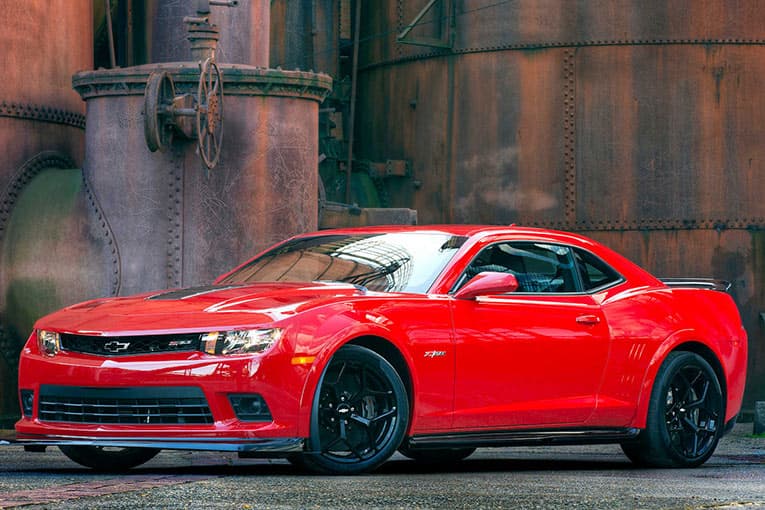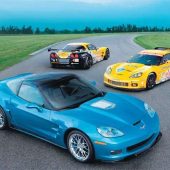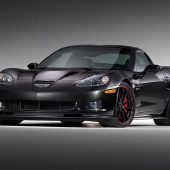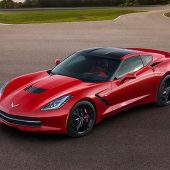he 2014 Chevrolet Camaro Z/28 is powered by the LS7 7.0-litre V8 engine. The Z/28 engine is adapted from the LS7 used in the C6 Corvette Z06, which was developed in conjunction with Corvette Racing. It is rated at an estimated 500 horsepower (373 kW) and 470 lb.-ft. of torque (637 Nm) in the new Chevrolet Camaro Z/28, with a maximum engine speed of 7,100 rpm – a broad rpm range that contributes to higher power and allows the driver to hold gears longer between shifts on the track. That helps keep the engine at peak power for quicker lap times.
Hand-assembled at GM’s Performance Build Center, in Wixom, Mich., the LS7 shares the basic Gen IV V-8 architecture as the Camaro SS’s 6.2L LS3 engine, but it uses a unique cylinder block casting with pressed-in steel cylinder liners to accommodate the engine’s larger diameter, 104.8mm cylinder bores – with deck-plate boring and honing for optimized bore geometry. It also uses a dry-sump oiling system to ensure full lubrication during the 1.05-g cornering loads the Z/28 is capable of producing.

Internally, the LS7’s reciprocating components use racing-derived lightweight technology, including titanium connecting rods and intake valves, to boost horsepower and rpm capability – and reduce overall engine mass. The titanium connecting rods provide perhaps the most direct link from the racetrack. They weigh just 464 grams apiece, almost 30 percent less than the rods in the LS3. Besides being lightweight, which enhances high-rpm performance and rpm range, titanium makes the rods extremely durable.
Engine highlights include
- Forged steel main bearing caps
- Forged steel crankshaft with 101.6-mm stroke
- Titanium connecting rods
- Aluminum flat-top pistons
- 11.0:1 compression
- High-lift camshaft
- Racing-derived CNC-ported aluminum cylinder heads with titanium intake valves and sodium-filled exhaust valves
- Hydroformed “tri-Y” exhaust manifolds
- High-capacity, liquid-to-liquid oil cooling system
- Unique cold-air induction system with low-restriction K&N air filter
- Unique engine cover with “Camaro 427” identification.
The LS7 exhaust system for the Camaro Z/28 is unique and features a tri-Y header design to take advantage of the V-8’s firing order. Primary pipe pairings join cylinders one and five, then three and seven on the left bank, with cylinders two and four and six and eight paired on the right bank. At each bank, the primary pairings collect into a secondary Y, delivering a combination of pulse separation of adjacent firing cylinders and improved scavenging for the engine’s firing order of 1-8-7-2-6-5-4-3. A dual-mode exhaust system and large, three-inch-diameter pipes complement the manifolds’ tuning and low restriction. The optimized header and exhaust system improves torque and sound quality from the LS7 engine.

The LS7’s CNC-ported aluminum cylinder heads are designed to meet the high airflow demands of the engine’s 7.0-liter displacement, as it ingests more than 100 cubic feet more air per minute than the LS3 V8 – a nearly 20-percent increase in airflow. To process that airflow capability, a hydraulic roller camshaft with 15mm intake and exhaust valve lift is used to allow plenty of air to circulate in and out of the engine. To ensure optimal, uninterrupted airflow, the LS7’s heads have straight, tunnel-like intake runners. Very large by production-vehicle standards – even racing standards – they are designed to maintain fast airflow velocity, providing excellent torque at low rpm and exhilarating horsepower at high rpm.
The heads feature 70cc combustion chambers that are fed by 56mm titanium intake valves, which are larger yet lighter than the valves in the LS3. They are partnered with 41mm sodium-filled exhaust valves, which feature hollow stems partially filled with a special sodium material that melts and liquefies around 205 degrees F (96 C). The inertia from the valves’ opening causes the liquefied sodium to move up inside the stem, dissipating heat better than a conventional exhaust valve.
To accommodate the large valve face diameters, the heads’ valve seats are Siamesed; and, taken from experience with the engines of Corvette race cars, the LS7’s valve angles are held at 12 degrees – vs. 15 degrees for the LS3 – to enhance airflow through the ports to get it into the combustions quicker and with less turbulence.

A dry-sump oiling system is used with the LS7 and is designed to keep the engine fully lubricated during the high-cornering loads the Camaro Z/28 is capable of producing. A 10.5-quart reservoir delivers oil at a constant pressure to a conventional-style oil pump pick-up at the bottom of the engine. The pressurized oil feed keeps the oil pick-up continually immersed in oil at cornering loads exceeding 1.05 g.
Oil circulates through the engine and down to the oil pan, where it is sent back to the reservoir via a scavenge pump. The large-capacity reservoir, combined with a high efficiency air-to-oil cooler, provides necessary engine oil cooling under the demands of the engine’s power output. With the dry-sump system, oil is added to the engine via the reservoir tank – which includes the oil level dipstick.
7.0L V8 (LS7) specifications
Displacement
- 427 cu in
- 7008 cc
Bore & stroke
- 4.125 x 4 in
- 104.8 x 101.6 mm
Block material
- cast aluminum

Cylinder head material
- cast aluminum
Valvetrain
- overhead valve
- two valves per cylinder
Fuel delivery
- SFI (sequential fuel injection)
Compression ratio
- 11.0:1
Horsepower
- 373 kW (500 hp) at 6300 (estimated)
Torque
- 470 lb-ft (637 Nm) at 4800 (estimated)
EPA-est. fuel economy
- 15 city
- 24 hwy










